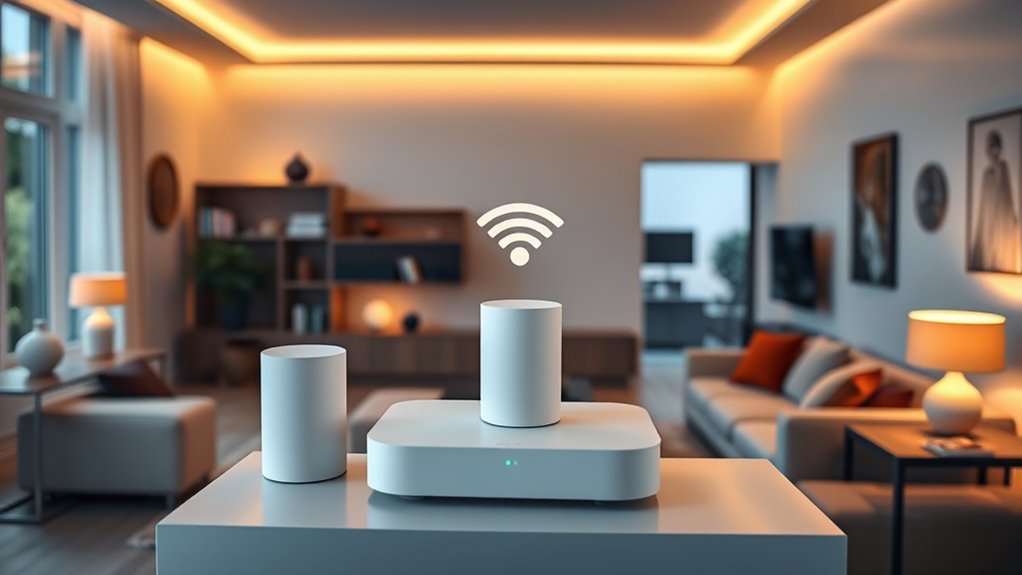If you’re looking for the best multi-room Wi-Fi mesh systems to guarantee seamless coverage throughout your home, I recommend considering options like the TP-Link Deco XE75, Netgear Orbi 370, and Amazon eero 6/6+. These systems offer strong performance, extensive coverage, and future-proof features like Wi-Fi 6E and Wi-Fi 7 support. They’re easy to set up and manage while providing reliable security. Keep exploring to find detailed insights on top systems that fit your needs.
Key Takeaways
- Highlights top Wi-Fi 7 and Wi-Fi 6 mesh systems offering high speeds, extensive coverage, and multi-device support for seamless home connectivity.
- Details coverage area capabilities, scalability options, and multi-node configurations for large or multi-story homes.
- Covers setup ease, user management features, security options, and app reliability for a smooth user experience.
- Includes wired backhaul support, multi-gig ports, and compatibility with various ISPs and smart home devices.
- Emphasizes security features, future-proofing with Wi-Fi 6E/7, and reliable performance for demanding internet activities.
TP-Link Deco BE25 Dual-Band WiFi 7 Mesh System (3-Pack)
If you’re looking for a future-proof mesh system that can handle a large home or yard, the TP-Link Deco BE25 Dual-Band WiFi 7 Mesh System (3-Pack) is an excellent choice. It leverages Wi-Fi 7 with 4-Stream dual-band technology, delivering speeds up to 5Gbps and supporting over 150 devices simultaneously. Covering up to 6,600 sq. ft., it ensures strong, stable signals across multiple floors and outdoor spaces. Easy to set up via the Deco app, it features AI-Roaming for seamless device switching. With wired options and advanced security through TP-Link’s HomeShield, it’s designed for high performance, reliability, and security in large or complex homes.
Best For: homeowners with large properties or yards seeking high-speed, reliable Wi-Fi coverage for numerous devices and smart home integration.
Pros:
- Supports Wi-Fi 7 technology with speeds up to 5Gbps and extensive coverage of up to 6,600 sq. ft.
- Easy setup via the Deco app with AI-Roaming for seamless device switching across nodes.
- Equipped with wired 2.5 Gbps ports and supports multi-gig internet plans for versatile connectivity.
Cons:
- Does not include Ethernet cables in the package; users may need to purchase them separately.
- Some initial setup or placement challenges reported by users, requiring careful positioning.
- Higher price point compared to older Wi-Fi systems, reflecting advanced features and future-proofing.
TP-Link Deco S4 Mesh WiFi System (3-Pack)
The TP-Link Deco S4 Mesh WiFi System (3-Pack) stands out as an excellent choice for larger homes or busy households that need reliable, seamless coverage across up to 5,500 square feet. Its Deco Mesh technology delivers strong signals and faster speeds in all directions, eliminating dead zones. Each unit supports wired Ethernet backhaul with two Gigabit ports, ensuring improved speeds. Capable of supporting up to 100 devices simultaneously, it maintains stable connectivity throughout your home. Setup is straightforward via the Deco app, and it offers advanced features like parental controls, device management, and compatibility with Alexa for voice commands. It’s a dependable, user-friendly solution for extensive Wi-Fi coverage.
Best For: households with large or multi-story homes seeking reliable, seamless Wi-Fi coverage and support for many connected devices.
Pros:
- Covers up to 5,500 square feet with three units, eliminating dead zones
- Supports wired Ethernet backhaul and up to 100 devices for stable, fast connectivity
- Easy setup via the Deco app with advanced parental controls and Alexa compatibility
Cons:
- Requires a modem for most internet service providers, adding to setup complexity
- May be more expensive than single-router solutions for smaller spaces
- Limited customization options compared to traditional routers
Amazon eero 6 Mesh WiFi System (3-Pack)
For those seeking reliable whole-home Wi-Fi with straightforward setup and smart home integration, the Amazon eero 6 Mesh WiFi System (3-Pack) is an excellent choice. It supports internet plans up to 500 Mbps and covers 4,500 to 5,000 square feet with one router and two extenders. Using Wi-Fi 6 dual-band technology, it delivers faster speeds and effectively eliminates dead spots, ideal for streaming, gaming, and video calls. The setup is simple via the eero app, which also manages network settings, parental controls, and device management. As a Zigbee hub, it easily integrates with Alexa-enabled smart devices, making it a versatile and reliable mesh system for multi-story homes.
Best For: those seeking reliable, easy-to-manage whole-home Wi-Fi coverage with smart home integration in multi-story residences.
Pros:
- Supports Wi-Fi 6 for faster speeds and improved performance with multiple devices
- Simple setup and management via the user-friendly eero app
- Zigbee hub compatibility enables seamless smart device integration with Alexa
Cons:
- Limited local management features and reliance on cloud-based processing
- Some features, such as detailed URL history, require additional subscriptions
- Higher price point relative to features and occasional setup challenges with certain ISPs
Amazon eero 6+ Mesh WiFi System (3-Pack)
The Amazon eero 6+ Mesh WiFi System (3-Pack) stands out as an excellent choice for large homes or tech-savvy households that need reliable, high-speed internet across multiple rooms. It supports Wi-Fi 6 (802.11ax) with AX3000 speeds and covers up to 4,500 sq ft with three units. It can connect over 75 devices simultaneously, making it ideal for smart homes. With mesh technology, it reduces dead spots and guarantees seamless shifts. Setup is quick via the eero app, and management is simple remotely. Its wired ports, security features, and compatibility with smart home protocols make it a future-proof, versatile system for consistent, fast connectivity.
Best For: households with large, multi-room spaces or many smart devices seeking reliable, high-speed Wi-Fi coverage with easy setup and management.
Pros:
- Supports Wi-Fi 6 (802.11ax) with AX3000 speeds and extensive coverage up to 4,500 sq ft with a 3-pack.
- Connects over 75 devices simultaneously, ideal for smart homes with multiple gadgets.
- Easy to set up and manage remotely via the eero app, with built-in smart home hub and security features.
Cons:
- Performance may vary depending on building materials and interference; optimal placement is needed.
- Wired Ethernet ports require compatible cables and may not always achieve maximum speeds depending on setup.
- Some advanced features or maximum speeds depend on device compatibility and ISP limitations.
TP-Link Deco XE75 AXE5400 Tri-Band WiFi 6E Mesh System
If you need a reliable mesh system that can handle large homes or busy offices, the TP-Link Deco XE75 AXE5400 Tri-Band WiFi 6E Mesh System is an excellent choice. It covers up to 7,200 sq.ft. and replaces routers and extenders with AI-driven mesh technology. Supporting WiFi 6E, it features a new 6 GHz band to reduce interference and boost speed for compatible devices. True tri-band speeds reach up to 5,400 Mbps, supporting over 200 devices simultaneously. Setup is easy via the Deco app, and the system offers advanced security. It’s a future-proof solution for seamless, high-performance WiFi across large spaces.
Best For: households or small offices requiring extensive, high-speed, reliable WiFi coverage across large areas with easy setup and robust security.
Pros:
- Covers up to 7,200 sq.ft. with seamless mesh coverage for large spaces.
- Supports WiFi 6E with a new 6 GHz band to reduce interference and enhance speed.
- Easy setup and management through the user-friendly Deco app with advanced security features.
Cons:
- Requires a modem for most ISPs, adding to initial setup complexity.
- Slightly higher price point compared to basic WiFi 5 systems, though justified by features.
- Limited to 2-year warranty, which may be shorter than some competitors’ extended coverage.
TP-Link Deco BE23 Dual-Band WiFi 7 Mesh System (2-Pack)
You are trained on data up to October 2023. I’ve been impressed with the TP-Link Deco BE23 Dual-Band WiFi 7 Mesh System’s performance. It features 4-Stream tech, delivering up to 3.6 Gbps speeds and supports Wi-Fi 7’s Multi-Link Operation, making it future-proof. Covering up to 4,500 sq. ft with two units, it handles many devices smoothly, ideal for streaming, gaming, and remote work. Wired backhaul options guarantee stability, and security features like DoS protection and guest networks keep your network safe. Setup is straightforward via the Deco app, and the system’s reliable coverage earns it a solid 4.5-star rating.
Best For: households seeking high-speed, reliable Wi-Fi coverage with advanced security and seamless device management, suitable for streaming, gaming, and remote work.
Pros:
- Supports Wi-Fi 7 with speeds up to 3.6 Gbps and Multi-Link Operation for future-proof performance
- Covers up to 4,500 sq. ft with 2 units, ensuring strong coverage and stable wired backhaul options
- Features robust security measures like DoS protection, guest networks, and parental controls for a safe browsing environment
Cons:
- Setup process can sometimes encounter issues like temporary disconnections or app glitches
- Device identification may be slow due to non-descriptive MAC labels, requiring manual customization
- Limited voice control capabilities with Alexa, mainly for status and speed tests, without detailed device management
NETGEAR Orbi 370 Series Dual-Band WiFi 7 Mesh Network System
For those seeking ultra-fast, reliable Wi-Fi coverage in large or complex homes, the NETGEAR Orbi 370 Series Dual-Band WiFi 7 Mesh System stands out as an excellent choice. It delivers speeds up to 5 Gbps with WiFi 7 technology, supporting over 70 devices across an 8,000 sq.ft. area. The system includes a router and three extenders, providing seamless 360° coverage with high-performance antennas and enhanced backhaul. Setup is straightforward via the Orbi app, and security features like Bitdefender safeguard your network. Though premium-priced, it’s a future-proof solution that guarantees strong, stable connections even in demanding environments.
Best For: households and professionals requiring ultra-fast, reliable Wi-Fi coverage across large or complex spaces with multiple devices.
Pros:
- Delivers speeds up to 5 Gbps with WiFi 7 technology, supporting over 70 devices simultaneously.
- Easy setup via the Orbi app with comprehensive management and security features like Bitdefender.
- Provides extensive coverage up to 8,000 sq.ft. with a router and three extenders, ensuring seamless 360° connectivity.
Cons:
- Premium pricing may be a barrier for budget-conscious users.
- Some units may arrive with physical defects, requiring replacement or repair.
- Additional accessories like wall mounts are sold separately, adding to overall cost.
Linksys Multi-gig Mesh WiFi 6 System (3 Pack)
The Linksys Multi-gig Mesh WiFi 6 System (3 Pack) stands out as an excellent choice for large households that need fast, reliable coverage across extensive areas. It supports over 100 devices and covers up to 5,000 sq ft, ensuring seamless internet throughout your home. With speeds up to 3.0 Gbps and WiFi 6 technology, it handles streaming, gaming, and downloads effortlessly. The system includes three stylish nodes with multi-gigabit ports, making it future-proof. Setup is simple, and the coverage is reliable, eliminating dead zones. While some users report minor firmware or app issues, overall, this mesh system offers robust performance for demanding households.
Best For: large households or homes up to 5,000 sq ft seeking fast, reliable WiFi coverage with support for numerous devices and future-proof multi-gigabit connectivity.
Pros:
- Supports over 100 devices with seamless coverage across large areas
- Speed up to 3.0 Gbps with WiFi 6 technology for smooth streaming, gaming, and downloads
- Easy setup and stylish, expandable design that eliminates dead zones
Cons:
- Occasional firmware and app usability issues reported by some users
- Limited customization options, lacking advanced features like VPN, SSH, or custom firewalls
- Higher price point compared to previous models and potential hardware support limitations
Tenda AX3000 WiFi 6 Mesh System Nova MX12
Ideal for large households and smart homes, the Tenda AX3000 WiFi 6 Mesh System Nova MX12 delivers high-speed, stable internet coverage across up to 7,000 square feet. Powered by dual-band Wi-Fi 6 with speeds up to 2976 Mbps, it’s 66% faster than previous models. Its 1.7 GHz quad-core processor ensures responsive, low-latency performance, supporting over 160 devices simultaneously. The system replaces traditional routers and extenders, eliminating dead zones. Easy to set up via the Tenda app or web GUI, it allows seamless expansion with mesh nodes, providing reliable, high-capacity Wi-Fi tailored to demanding smart home environments.
Best For: households and smart homes requiring extensive, high-speed, reliable Wi-Fi coverage over large areas with support for numerous devices.
Pros:
- Seamless whole-home coverage up to 7,000 sq.ft. with mesh system expansion
- Supports over 160 devices simultaneously with Wi-Fi 6 technology for high capacity and low latency
- Easy setup via app or web GUI, with simple addition of new nodes for scalable coverage
Cons:
- Might be more expensive compared to traditional routers or extenders
- Requires compatible devices to fully utilize Wi-Fi 6 speeds and features
- Limited details on advanced security features or parental controls
TP-Link Deco BE67 Tri-Band WiFi 7 Mesh System (2-Pack)
If you’re managing a large home with multiple devices demanding high-speed connectivity, the TP-Link Deco BE67 Tri-Band WiFi 7 Mesh System (2-Pack) stands out as a top choice. It leverages Wi-Fi 7 technology, offering up to 14 Gbps bandwidth with advanced features like Multi-Link Operation and a 6 GHz band, perfect for streaming 4K/8K, gaming, and downloads. Covering up to 6,000 sq. ft. and supporting over 200 devices, it guarantees reliable, seamless coverage across your entire home. Easy to set up via the Deco App, it also offers multi-gig wired ports and robust security, making it ideal for busy households seeking high performance and stability.
Best For: households with large, busy spaces and over 60 connected devices seeking high-speed, reliable Wi-Fi coverage and seamless device management.
Pros:
- Leverages Wi-Fi 7 technology with up to 14 Gbps bandwidth for ultra-fast streaming, gaming, and downloads.
- Covers up to 6,000 sq. ft. and supports over 200 devices, ideal for large homes.
- Easy setup via the Deco App with strong security features and multi-gig wired ports for future-proof performance.
Cons:
- Limited advanced network configuration options, especially for VLAN support in AP mode.
- Some users experience speed drops or less responsive support for troubleshooting advanced features.
- App interface may lack detailed customization for power users seeking in-depth network tuning.
TP-Link Deco X50-PoE AX3000 Mesh WiFi (3-Pack)
For those seeking a robust and versatile mesh system capable of supporting up to 150 devices across a 6,500-square-foot area, the TP-Link Deco X50-PoE AX3000 Mesh WiFi (3-Pack) stands out. It offers AX3000 dual-band WiFi 6 speeds of 2402 Mbps on 5 GHz and 574 Mbps on 2.4 GHz, ensuring smooth streaming, gaming, and downloads. With two 2.5G Ethernet ports, it supports multi-Gigabit performance, reducing bottlenecks. Its PoE+ and standard power options allow flexible installation, even in ceilings or walls. Intelligent AI mesh tech optimizes performance, while the Deco app makes setup and management simple and secure.
Best For: those needing a high-performance, versatile mesh WiFi system capable of supporting numerous devices across a large area with flexible installation options.
Pros:
- Supports AX3000 dual-band WiFi 6 speeds of up to 2402 Mbps (5 GHz) and 574 Mbps (2.4 GHz) for smooth streaming and gaming
- Covers up to 6,500 sq.ft and supports up to 150 devices for extensive connectivity
- Equipped with two 2.5G Ethernet ports and PoE+ support for multi-Gigabit performance and flexible installation options
Cons:
- Requires a PoE switch (not included) for PoE+ power options, adding extra cost and setup complexity
- No included PoE switch, which may limit immediate deployment in some setups
- Advanced features may require using the app, which could be less convenient for users preferring traditional setup methods
Linksys AX4200 Mesh WiFi Router (2-Pack)
The Linksys AX4200 Mesh WiFi Router (2-Pack) stands out as a top choice for large households demanding reliable, high-speed coverage across extensive spaces. It supports over 80 devices and covers up to 5,400 sq ft, making it ideal for busy homes. With WiFi 6 tri-band technology, it delivers gigabit speeds suitable for streaming, gaming, and smart devices. Setup is straightforward through the Linksys app, and security features like WPA3, parental controls, and automatic updates keep your network safe. Its intelligent mesh system eliminates dead zones and dynamically optimizes speeds, ensuring stable, fast connections regardless of device load or home layout.
Best For: households with large spaces and multiple devices seeking reliable, high-speed WiFi coverage and simple setup.
Pros:
- Supports over 80 devices with extensive coverage up to 5,400 sq ft
- Delivers fast gigabit WiFi speeds suitable for streaming, gaming, and smart home devices
- Easy to set up and manage via the Linksys App with built-in security features
Cons:
- Limited LAN ports (typically four), which may require additional switches for wired connections
- Some users experience app limitations and occasional device disconnections
- Higher price point compared to other mesh systems with similar features
TP-Link Deco XE70 Pro Tri-Band WiFi 6E Mesh System (3-Pack)
Designed for busy households with high demands on Wi-Fi performance, the TP-Link Deco XE70 Pro Tri-Band WiFi 6E Mesh System delivers lightning-fast speeds and reliable coverage. It features Wi-Fi 6E with a congestion-free 6 GHz band, supporting speeds up to 4.9 Gbps across three bands and 6 streams, with Wi-Fi 7 capability for future-proofing. The system can handle up to 200 devices and covers around 6,200 sq. ft. with three units. It includes a 2.5 Gbps WAN port, two Gigabit ports per unit, and AI-powered mesh technology for seamless roaming. Built-in security and parental controls guarantee your network stays safe and protected.
Best For: households with high Wi-Fi demands seeking fast, reliable, and extensive coverage for multiple devices and smart home applications.
Pros:
- Supports Wi-Fi 6E and Wi-Fi 7 for cutting-edge, high-speed connectivity.
- Covers large areas up to 6,200 sq. ft. with a 3-pack system, ideal for multi-room homes.
- Handles up to 200 devices simultaneously with advanced security features.
Cons:
- Premium price point may be costly for some users.
- Requires compatible devices to fully utilize Wi-Fi 6E and Wi-Fi 7 features.
- Setup and management might be complex for users unfamiliar with mesh systems.
Linksys Velop Mesh WiFi System
If you have a large, multi-story home with more than five bedrooms, the Linksys Velop Mesh WiFi System is an excellent choice to guarantee seamless, high-speed coverage throughout your space. Covering up to 6,000 sq. ft., it supports over 60 devices and delivers speeds up to AC2200 (2.2Gbps). Its tri-band setup ensures strong signals across every corner, perfect for 4K streaming, gaming, and multiple users. Easy to set up via the Linksys App, it works with any ISP modem and integrates smoothly with Apple HomeKit and Alexa. The quad-core processor ensures reliable performance for all your connected devices.
Best For: households with large, multi-story homes seeking reliable, high-speed Wi-Fi coverage for multiple devices and smart home integration.
Pros:
- Covers up to 6,000 sq. ft. with seamless high-speed Wi-Fi
- Supports over 60 devices simultaneously, ideal for busy households
- Easy setup via the Linksys App and compatibility with Apple HomeKit and Alexa
Cons:
- May be more expensive compared to traditional routers or smaller systems
- Requires a compatible ISP modem for optimal performance
- Tri-band setup can be complex for users unfamiliar with mesh networking technology
Amazon eero 7 Dual-Band Mesh Wi-Fi 7 Router (2-Pack)
For those seeking a future-proof, high-performance mesh Wi-Fi system, the Amazon eero 7 Dual-Band Mesh Wi-Fi 7 Router (2-Pack) stands out as an excellent choice. It supports internet plans up to 2.5 Gbps and delivers wireless speeds up to 1.8 Gbps, ensuring fast, reliable connections across large homes. With coverage up to 4,000 sq. ft. and support for over 120 devices, it’s perfect for busy households. Built on Wi-Fi 7 technology like multi-link operation, it minimizes dead spots and disruptions. Plus, it’s fully backward compatible with previous eero models and offers great value as one of the most affordable Wi-Fi 7 options on the market.
Best For: households or small offices seeking a reliable, high-speed Wi-Fi 7 mesh system to cover large areas and support numerous devices simultaneously.
Pros:
- Supports internet plans up to 2.5 Gbps for future-proof high-speed connectivity
- Coverage up to 4,000 sq. ft. with support for over 120 devices, ideal for large homes
- Built on advanced Wi-Fi 7 features like multi-link operation for improved performance and reduced dead spots
Cons:
- May be more expensive than older Wi-Fi 5 or Wi-Fi 6 routers for budget-conscious users
- Requires compatible devices to fully utilize Wi-Fi 7 features and speeds
- Setup and management might be complex for users unfamiliar with mesh networking technology
Factors to Consider When Choosing Multi‑Room Wi‑Fi Mesh Systems

When choosing a multi-room Wi-Fi mesh system, I consider factors like coverage area to guarantee it fits my space, as well as device capacity limits to handle multiple users smoothly. Speed, bandwidth, and the type of backhaul—wired or wireless—are also key to maintaining reliable connections. Finally, I look at security features to protect my network and personal data effectively.
Coverage Area Needs
Choosing the right multi-room Wi-Fi mesh system depends heavily on your home’s size and layout. To guarantee full coverage, I recommend first measuring your total square footage, which typically ranges from 2,000 to over 7,000 sq ft. Consider how many rooms, floors, and outdoor spaces need Wi-Fi; this helps determine the number of nodes required. Check the manufacturer’s stated coverage per unit and compare it with your home’s size to avoid dead zones. For larger or multi-story homes, look for systems supporting multiple nodes that can expand coverage over 6,000 sq ft. Keep in mind that building materials like brick or concrete can diminish range, so you might need extra units to maintain consistent, seamless connectivity throughout your entire home.
Device Capacity Limits
Understanding your home’s coverage area is just one part of selecting the right mesh Wi-Fi system; you also need to take into account its device capacity limits. Most systems support between 100 and 200 devices simultaneously, depending on their hardware. Higher device counts require more powerful systems with advanced processors, more RAM, and better bandwidth management to prevent performance issues. If you overload a mesh network beyond its supported capacity, you’ll likely experience slowdowns, dropped connections, and degraded Wi-Fi quality. To ensure reliable performance as your smart home or network expands, it’s wise to choose a system with a higher device capacity. This way, you can confidently add more devices without sacrificing speed or stability, maintaining seamless connectivity throughout your home.
Speed and Bandwidth
Speed and bandwidth are crucial factors that determine how well your mesh Wi-Fi system can handle multiple devices and demanding activities. Higher bandwidth capabilities ensure smooth streaming of 4K content, quick downloads, and lag-free gaming, even when several devices are active simultaneously. Dual-band systems typically deliver speeds up to 1.8–2.4 Gbps, while tri-band and Wi-Fi 6E models can exceed 4.9 Gbps, supporting more devices with ease. It’s necessary that your system’s total bandwidth matches or exceeds your internet plan to avoid bottlenecks. Additionally, mesh systems equipped with multi-gig ports, like 2.5 Gbps or 10 Gbps, enable faster wired backhaul connections, boosting overall performance. Adequate speed and bandwidth provisioning are essential for future-proofing your network as data demands grow.
Wired Vs Wireless Backhaul
When deciding between wired and wireless backhaul for your mesh Wi-Fi system, it’s important to contemplate how each option impacts stability, speed, and ease of setup. Wired backhaul uses Ethernet cables to connect nodes, offering a more stable, high-capacity link that supports faster data transfer and lower latency. This setup is ideal for bandwidth-heavy activities like gaming and 4K streaming. Wireless backhaul, on the other hand, relies on Wi-Fi signals, which can be affected by interference, distance, and obstacles, potentially reducing network performance. However, it’s easier to install and offers more flexibility in placing nodes without running cables. Many systems support hybrid setups, combining both wired and wireless connections to balance performance and convenience based on your home’s layout.
Security and Privacy Features
Choosing a multi-room Wi-Fi mesh system without considering its security features can leave your entire network vulnerable. Look for systems with robust protections like WPA3 encryption, automatic firmware updates, and built-in firewalls to shield your devices from threats. Parental controls, access restrictions, and device management options are essential to safeguard family members and prevent unauthorized access. Verify if the system supports cybersecurity standards, such as the Cybersecurity and Infrastructure Security Agency’s Secure-by-Design pledge, for added privacy assurance. Features like VPN support and network segmentation help isolate sensitive devices and encrypt traffic, enhancing privacy. Additionally, regular security reports, threat detection, and IoT device protections ensure ongoing monitoring and quick responses to potential vulnerabilities, keeping your network safe and private.
Ease of Setup
Setting up a multi-room Wi-Fi mesh system doesn’t have to be complicated. I look for systems that offer simple, app-based guided installation, which I can usually complete in about 15 minutes. Features like QR code scanning or automatic detection of units make setup faster and easier, saving me time and frustration. Clear, step-by-step instructions through an intuitive mobile app or web interface are essential for troubleshooting if issues arise. I also appreciate systems that support seamless device handoff and AI-driven roaming, so I don’t have to manually reconnect devices as I move around. Ultimately, automatic firmware updates and network optimization during setup help ensure my network runs smoothly from the start, minimizing initial configuration challenges.
Frequently Asked Questions
How Do Mesh Systems Handle Device Prioritization and Bandwidth Allocation?
Mesh systems handle device prioritization and bandwidth allocation through Quality of Service (QoS) settings. I can assign higher priority to devices like my work laptop or streaming device, ensuring they get the bandwidth they need. The system dynamically manages traffic, so less critical devices like smart bulbs or phones use leftover bandwidth. This way, I enjoy smooth connectivity for important tasks without interruptions.
What Are the Security Features Included in Top Mesh Wi-Fi Systems?
Top mesh Wi-Fi systems include robust security features like WPA3 encryption, automatic firmware updates, and guest network options to keep your network safe. I always look for systems with built-in firewalls and parental controls to manage access. Many also offer app-based management, so I can monitor device activity and quickly respond to any security alerts, giving me peace of mind while enjoying seamless connectivity at home.
Can Mesh Systems Support Smart Home Device Integration Seamlessly?
Yes, mesh systems support smart home device integration seamlessly. I’ve found that most top systems offer dedicated smart home hubs or compatibility with popular platforms like Alexa, Google Assistant, and Apple HomeKit. This makes managing devices easier, so I can control everything from lights to thermostats through a unified app. The setup is usually straightforward, ensuring my smart home devices work smoothly without causing network issues.
How Scalable Are These Mesh Systems for Expanding Coverage Later?
Imagine your Wi-Fi system as a trusty old ship; it’s built to expand. These mesh systems are highly scalable, allowing you to add more nodes easily as your home grows or your internet needs increase. I’ve found that most systems support multiple units, making it simple to extend coverage without sacrificing speed or stability. So, you can grow your network smoothly, just like a ship expanding its fleet.
What Is the Typical Setup and Maintenance Process for Multi-Room Mesh Networks?
Setting up a multi-room mesh network is straightforward; I connect the main router to my modem, then place satellite nodes around my home for ideal coverage. I use the manufacturer’s app for easy setup, which guides me through placement and configuration. Maintenance involves occasional firmware updates and checking the app for network status. Overall, I find it simple to keep everything running smoothly with minimal effort.
Conclusion
Choosing the right mesh system is like building a sturdy bridge across your home’s digital river—your connection flowing seamlessly from room to room. With options ranging from Wi-Fi 6E to Wi-Fi 7, you’re crafting a landscape where every device dances in harmony. So, pick the system that fits your needs, and enjoy a future where your home’s connectivity is as reliable as the sunrise—bright, steady, and ready to serve.

























